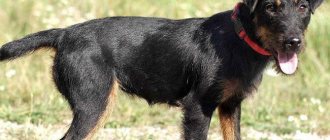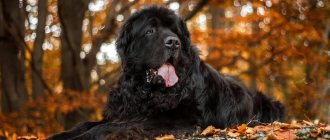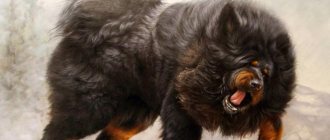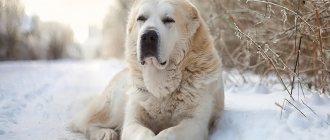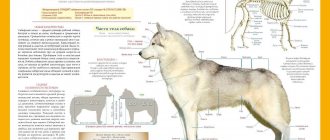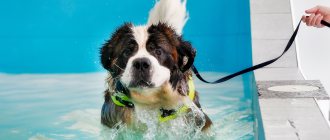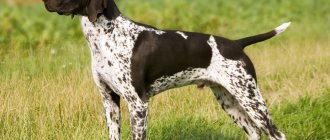Breed characteristics
| Short description | |
| Origin: | Germany |
| Conditions of detention: | Country house with a large plot, apartment |
| Purpose: | Hunter |
| Color: | Black or brown and tan |
| Wool length: | 2 – 4 cm |
| Adult dog size: | Height 34 – 39 cm, weight 8 – 10 kg |
| Average life expectancy: | 13 – 15 years |
| Walk: | Mandatory, daily |
| Physical activity needs: | High, from 3 hours a day |
| Fédération Cynologique Internationale (FIC) classification: | Group 3, section 1 |
| Puppy price: | From 5,000 to 35,000 rubles |
Health and diseases of Jagdterriers
This section is the shortest. All efforts of German breeders were aimed at obtaining a reliable dog, free from problematic heredity. This was 95% successful - another record in cynology.
DJT-Club specialists intend to cope with the remaining risks, for which they have introduced a standard for admission to breeding in the form of the PLL test. Laboratory analysis establishes a genetic predisposition to primary lens luxation. This pathology can cause early blindness in dogs.
PLL is not a specific problem of NOT, as confirmed by the results of a herd survey in Germany. The defective gene was found in only 2.5% of Jagdterriers, and they were excluded from breeding.
Likewise, the club intends to eradicate another potential threat – myopathy. These preventive measures may be considered excessive, but German dog handlers strive for an ideal result.
Nonspecific diseases of the Jagdterrier are associated with its work and character. Mostly these are injuries. If hunting practice is successful, dogs live up to 13–15 years.
History of the origin of the species
The history of the breed is not shrouded in myths and legends, due to the relative youth of the species - Jagdterriers trace their gene pool from fox terriers rejected for color. In the 20s of the 20th century, exhibitions became fashionable, and the selection of fox terriers was aimed at the exterior, which significantly reduced the working qualities of the dogs. Walter Zangenberg, a hunter and owner of fox terriers, was disappointed with the new characteristics of the breed, and was inspired by the idea of breeding a new species - ideal for hunting.
To the defective fox terriers, Walter mixed the genetic codes of English wire-haired terriers, Welsh terriers and other dogs with first-class working qualities, relegating appearance to the background. In just 10 years, Zangenberg managed to get two hundred black and tan dogs of the same type, which he named German Jagdterrier . But the International Canine Federation accepted the breed only in 1954.
History of the breed
The German Jagdterrier is a specially bred working breed of dog, equally effective in hunting hares, burrows and ungulates. Its name means hunting terrier. The ancestors of the Yagds were English fox terriers, known for their ability to drive small and large game. At the beginning of the 20th century, Foxes gained unprecedented popularity and began to be used as decorative dogs. Breeders rejected puppies with atypical colors, which were highly valued by hunters: the dark coat was invisible in the forest and did not require careful care.
The founders of the breed are Walter Zangenberg, Rudolf Fries and Karl-Erich Gruenewald. In 1923, they crossed black and tan terriers and dark fox terriers. The result was compact, black dogs that could easily crawl into holes and hunt large animals.
In 1926, the German Jagd Terrier Club was created, which formulated the basic idea: dogs must remain externally unattractive in order to maintain all working qualities. Yagdas were positioned as burrowing dogs and were unthinkable as pets. In 1927, the first special breed exhibition was held. Breeders seriously thought about the problems of inbreeding and decided to mate Yagds with Welsh Terriers and Old English Terriers. Later, this list was supplemented by the dachshund, the German hound, the pinscher and the Lakeland terrier. In 1934, the official breed standard was published. In 1954, Jagd Terriers received recognition from the FCI. They came to Russia in the 70s and gained wide popularity.
Distinctive features
Description of the German Jagdterrier breed:
- General form. A strong, compact dog with a slightly stretched format.
- Height. At the withers, males have 34–40 cm, females 33–39 cm, weight 8–10 kg and 7–9 kg, respectively.
- Head. Small, wedge-shaped, tapering towards the nose. The occipital protuberance and the transition from the forehead to the muzzle are poorly defined. The eyes are symmetrically located, the shape is close to almond-shaped, brown or dark brown in color. The ears are small, triangular with a crease in the cartilage, set high and close to each other.
- Muzzle. Narrow, nose black or brown, lips tightly fitting. Scissor bite, jaws strong, teeth tightly clenched.
- Neck. Dry, without dewlap, with pronounced muscles.
- Frame. Compact but muscular, lacking dampness. The stomach is tucked in, the back is straight and strong. The ribs protrude slightly, the chest is moderately wide, descending to the level of the elbows.
- Limbs. Straight, parallel, fingers closed. The thighs are strong, muscular, the hock joints are well defined.
- Tail. It is docked and 2/3 is left. Set on moderately, in an excited state the dog holds it above the level of the back.
- Coat and color. The coat is thick and dense, in two variations - wire-haired and smooth-haired. There is very little undercoat. Colors are black or brown and tan.
Sexual dimorphism is moderately expressed and is welcomed in exterior assessment.
Video
* We invite you to watch a video about the German Jagd Terrier . In fact, in front of you is a playlist in which you can select and watch any of 20 videos about a given dog breed by simply clicking on the button in the upper right corner of the window. In addition, the material contains quite a lot of photos. By looking at them you can find out what a German Jagd Terrier looks like.
In this article:
|
Rate the material!
[Total votes: 3 Average: 3.3]
The German Jagdterrier was bred specifically for hunting. Gradually, dogs turned into faithful comrades and associates even for those who have nothing to do with hunting. Let's try to study all the most interesting things associated with this breed, from its origin to the cost of this amazing dog.
Photo of an adult dog
Photos of puppies
Smooth-haired Jagdterrier photo
Features of behavior
As befits a real hunter, the Jagdterrier is distinguished by exceptional energy. This is a dog who never sits still. And if the energy is not directed in a peaceful direction, the child begins to look for things to do on his own - chewing furniture, digging holes, chasing cats. It is absolutely not suitable for lazy and melancholy people, but in hunting or sports the breed has no equal.
To this day, the Jagdterrier has retained amazing working qualities. This dog has an excellent sense of smell, endurance and a desire to work, thanks to which the breed is gradually moving from a burrow hunter into the category of universal hunters. Yagi are capable of hunting small burrow predators, swamp and steppe game, and ungulates with equal success.
The German Hunting Terrier cannot be called a dog with high communication skills. The breed does not get along well with other animals (especially rodents or birds); due to its innate leadership qualities, the dog can start fights on the street with other dogs. Treats strangers with caution, but without excessive aggression. Although with a good level of early socialization this deficiency can be reduced, it cannot be completely eradicated.
Another feature of the breed is courage, absolute and sometimes reckless. When going out to fight a predator, or defending a dog’s owner, the instinct of self-preservation is completely turned off. Which is fraught with injury, since the Jagdterrier’s opponent’s size never stops him; he is ready to fight to the death with anyone.
The breed is not suitable for novice dog breeders; it has a complex character. During educational processes, a poorly motivated child often displays remarkable stubbornness and self-will. And with harsh correction methods, he may snap back. Hunting breeds that do not know how to show independence in real hunting conditions are doomed to death; in Jagdterriers it is this trait that complicates the educational process.
Advantages
The German Hunting Terrier has a lot of advantages:
- Intelligence and quick reaction;
- Irrepressible energy;
- Strength and endurance;
- Good hunting instinct;
- Excellent hearing and sense of smell;
- Courage;
- Ability to make independent decisions;
- Compact dimensions;
- Easy to care for;
- Good health;
- Good security qualities;
- Unpretentiousness in content.
All the advantages of this little dog cannot be included in one list.
Flaws
Of course, despite all the advantages of the breed, there are also disadvantages:
- Poor level of communication;
- Hyperactivity;
- Lack of self-preservation instinct;
- Difficulty in training;
- Stubbornness;
- Frequent injuries.
Unbridled energy, splashing from a small body, from an advantage, easily turns into a disadvantage, if the content is inappropriate for this breed.
Care and maintenance
The ideal housing option for a German Hunting Terrier is a country house with a large and securely fenced area. But a spacious area for a splash of energy does not mean that you don’t have to exercise your dog; out of boredom, the dog will dig holes and gnaw trees and bushes on the site. Having your own reservation does not eliminate the need to walk and socialize the yagda.
The compact dimensions of the breed allow you to keep the yagda in an apartment, but subject to daily active walking for at least 3 hours a day.
Otherwise, caring for a Jagdterrier is not a hassle:
- Clean your ears from dirt once every two weeks;
- Brush your teeth once a month;
- Carry out a preventive dental examination at the veterinarian twice a year;
- Once a week, wipe your eyes with a special lotion;
- Carry out preventive deworming once a trimester;
- Vaccinate against infectious diseases once a year;
- As necessary, carry out ectoparasite prevention.
In fact, this is a minimum set of procedures for caring for a dog.
Nutrition
The recommended feeding regimen for dogs is presented in the table:
| Age | Mode |
| 1 – 3 months | Fractional feeding in small portions every 3 hours 6 – 7 times a day |
| 3-5 months | 5 times a day |
| 5 – 7 months | 4 times a day |
| 7 – 11 months | 3 times per day |
| 11 or more months | It is acceptable to switch to the adult dog’s regimen – 2 feedings per day |
As for the diet, the choice is up to the owner - Jagdterriers are healthy dogs, the owner’s task is only to maintain the animal’s condition with decent nutrition.
Dry food of good quality costs a lot of money, but decent feeding with natural products takes a lot of time, and financially it doesn’t work out much cheaper.
Authorized products:
- Meat (any except fatty variations - lamb and pork) and offal (any except kidneys and liver). Should form the basis of the diet. A carnivore does not need to cook meat.
- Fish. Any varieties of white sea fish without bones, it is enough to give once a week.
- Fermented milk. With fat content no higher than 5%.
- Eggs. Only the white is better; boiled yolks have a lot of sugar.
- Cereals. The source of complex carbohydrates is oatmeal and rice, but no more than 10% of the total diet; the dog will not receive anything useful except excess weight if there is an excess of cereals.
- Cartilage and tendons. Also in raw form, very rich in protein.
- Vegetables and unsweetened fruits. Only in fresh form, otherwise they have no vitamin value.
Prohibited Products:
- Sweets, including sweet fruits (such as grapes)
- Flour products. With the exception of dried rye bread.
- Sausages and smoked meats.
- Salt and spices are also not needed by the predator.
- Marinades.
- Sharp or tubular bones.
All these products can cause acute and chronic diseases of the stomach, pancreas or injure the esophagus. And cereals such as millet, semolina, and pearl barley are not digestible in the dog’s body.
We recommend that you read a detailed article on the topic: “How and what to feed a dog: types and characteristics of nutrition.”
Health
Breeders, when breeding the breed, tried to avoid common genetic diseases - successfully . Today, breeders actively continue to work to maintain the state of the gene pool in the same form. Sick individuals (both physically and mentally) are completely excluded from breeding. Thanks to this, with proper care, Jagdterriers can easily live up to 14 - 15 years , without age-related or breed-related ailments.
The only problem that the owner of a jagda may encounter is injuries received in fights with wild or other domestic animals.
Vaccinations
- The first veterinary procedures must be carried out by the breeder - at about 6 weeks, prevent helminths for the entire litter, and after 2 weeks, double deworming.
- By the 10th week of life (no later), the owner must provide a vaccine against a minimum set of viral infections - enteritis, Carré's disease and viral hepatitis.
- Additionally, your veterinarian may prescribe another vaccine against a disease found in a particular region.
- After 28–30 days , a double vaccination is given to strengthen immunity. If the puppy is healthy and active, they immediately give an injection for rabies. If the dog lives in “greenhouse” conditions, the doctor may postpone the rabies vaccination until the teeth are completely replaced.
- After revaccination, it is recommended to observe another 2 weeks of quarantine.
- The last puppy vaccination is given at the age of 12 months . Then, every year, immunization against rabies and viral infections is carried out (with one or two sera).
Preventive deworming is carried out before each vaccine.
On the days of veterinary procedures, the pet may experience lethargy, drowsiness, lack of interest in active games, one-time refusal to feed, and even one-time vomiting. Allergic reactions to modern medications practically do not happen.
Important article on the topic: “Everything you need to know about dog vaccinations.”
Diseases
There is no visible tendency towards genetic diseases. Completely healthy breed.
Walk
Regardless of living conditions (house, enclosure, apartment), the Jagd Terrier requires a mandatory daily walk - at least 3 hours a day. At the same time, the pet needs not only to run, but also to receive mental exercise. Without a proper outburst of activity, the dog is inclined to exhibit destructive behavior.
Even working dogs that go fishing during the season are recommended to simultaneously engage in obedience walks or canine sports. The breed is perfect for canicross, frisbee dog, agility, and bikejoring.
Grooming
To care for the coat of a Jagdterrier, no special skills or equipment are required - it is enough to comb out dead hairs with a slicker brush or furminator once a week, during the period of seasonal molting - every other day.
Bathing procedures are also not required too often, especially if the dog lives in an enclosure. Berries need to be washed no more than 3-4 times a year, but for dogs kept in enclosures, one wash per year is enough.
Maintenance and care
The Jagdterrier (reviews from dog breeders convince us of this) does not require complex care. As already mentioned, once a week it is necessary to comb the dog’s fur so that it does not get tangled and has a beautiful and healthy appearance.
The animal should be bathed as soon as it gets dirty, as well as after being in an open body of water. In addition, it is necessary to regularly clean the animal's ears and teeth. If the claws do not grind down on their own, they should be trimmed.
The Jagdterrier requires significant daily exercise. He feels more comfortable in a large yard, where the dog can run independently as much as he needs. When kept in an apartment, the animal becomes restless and very restless. In addition to freedom of movement, the Jagdterrier needs attention and love.
Mating
According to the regulations on breeding work published on the website of the Russian Cynological Federation, completely healthy individuals who have reached the age of 18 months are allowed to breed . In females, this is usually the third estrus.
A prerequisite for mating is to meet a male on the territory; females often behave aggressively on their reservation.
Mating is prescribed on days 9–14 of estrus ; depending on the characteristics of the body, ovulation does not occur on a specific day. To obtain reliable information about readiness for mating, it is recommended to take a special ovulation test (the male is ready for mating all year round). Before mating, both individuals need to be treated against parasites and vaccinated.
Read a detailed article on the topic: “Everything you need to know about breeding dogs: appropriate age, what to do if it doesn’t work out, rules and tips.”
Description of the breed
The Jagdterrier is considered a young breed that appeared in Germany at the beginning of the twentieth century. One of the most important features of these dogs is their versatility; they are used in hunting large animals - bear, wild boar, elk, as well as beaver in burrow hunting and birds. But in the countries of the former USSR they are usually used in hunting foxes and badgers.
Another positive quality of the breed is its unpretentiousness. It allows these dogs to be used in all weather conditions at all times of the year. The coarse coat, which even covers the belly and inner thighs, retains heat and protects from snow, wind and moisture.
Breed standard
Dogs of this breed have a dry, lean constitution, thanks to which they are able to cover significant distances. German Jagd Terriers are small in size. Their height does not exceed 40 cm at the withers, and their weight is 12 kg. The Jagdterrier is the only breed for which the proportion of height and chest girth is considered an important criterion. These dogs come in smooth and long hair.
Character and behavior
The Jagdterrier is a serious hunting breed. Its representatives demonstrate in the field aggression, fearlessness and strength in a fight with a wild animal much larger than themselves. In the family, Jagdterriers show patience and are affectionate and restrained with children.
Possible diseases
The Jagdterrier breed was bred as a universal and unpretentious hunting breed; as a result of selection, most diseases were excluded. However, these dogs have a hereditary disease - Edward Ehlers syndrome - dermatorexis. The disease manifests itself in hypersensitivity of the skin. Otherwise, Jagdterriers have good health and are not at risk of developing many chronic diseases.
Care and feeding
Particular attention should be paid to the fur and skin of dogs. Representatives of this breed should be walked more often, especially if the animals are kept in an apartment. Otherwise, unpretentious Jagdterriers do not require special care. The diet should be balanced. Per kilogram of adult dog weight, the ratio of nutrients per day is:
- 4-5 g protein;
- 2-3 g fat;
- 12-15 g carbohydrates.
Food should be high in calories, especially for dogs that take part in hunting. The number of calories changes depending on the physical activity of the Jagd Terrier. Dairy products and vitamin-mineral complexes should be added to the puppy’s diet.
Education and training
The dog has a complex character, and in order to properly raise it, the owner will need certain knowledge and skills. The main goal will be to develop the positive qualities of the breed and reduce the negative ones from an early age.
Key points in training
Due to their natural increased activity and some stubbornness, training a German Hunting Terrier is a troublesome task. But the breed is quite smart, and with the right approach, it can be trained well. The owner will have to choose his motivation very carefully and become even more stubborn than the pet . Skill development should be short, but daily , and based solely on positivity, then success will be ensured.
The Jagdterrier knows his own worth and will not allow cruelty and tyranny towards himself. For beginner dog breeders, it is better to contact a professional instructor for questions about breed training.
Read about how to properly train a dog in the article: “Training a puppy: effective methods from dog handlers, learning commands at home.”
Features of the Jagdterrier breed
Despite their small size, the dogs are very aggressive and fearless towards game and other animals. It is worth noting that the Jagdterrier dog can also show aggression and intolerance towards humans, that is, owning a dog of this breed is advised only to people who know how to pacify and tame these fearless hunters. Otherwise, you first need to read the deplorable reviews about Jagdterriers from inept owners.
In the photo there is a long-haired Jagdterrier dog
Training is carried out from an early age, and it is impossible to show leniency and forgive Jagdterrier puppies for tricks characteristic of their age. Representatives of the breed are extremely willful, and if you miss the moment, it is almost impossible to re-educate the dog.
Hunting with the German Jagdterrier is carried out mainly on burrowing animals. Strong paws and impressive claws help the dog to easily tear holes and reach animals that are hiding there. The special structure of the jaw allows the dog to kill the victim without spoiling the fluffy skin.
Cost and choice of puppy
Since the breed is absolutely not commercial, prices for Jagd Terrier puppies are quite affordable. For 25,000 - 35,000 rubles you can buy a worthy representative, in a professional nursery, from working parents. A puppy without documents costs from 5,000 rubles . But without a pedigree, cynological organizations do not recognize the breed and permission to hunt cannot be obtained.
It is better to buy a future pupil from a nursery that has good reviews . When getting to know the litter, you need to pay attention to the living conditions and health status of the dogs. It’s good if the breeder has documents confirming the absence of genetic diseases.
Basic rules when choosing a Jagdterrier:
- It is unacceptable for small puppies (without vaccinations) to roam freely around the yard - there is an increased risk of contracting a helminthic infestation.
- No hernia in the navel area.
- Clean, shiny coat, without signs of bald patches, dandruff, or dermatitis.
- The puppy must be at least 6 weeks old when sold.
- Absence of all kinds of discharge from the ears, nose, eyes.
- Availability of a veterinary passport with notes on all events.
Upon visual inspection, the future owner of the puppy should not have the slightest doubt about the pet’s health (both physical and psychological).
approximate cost
In Russia you can buy a Jagd Terrier puppy for approximately the following amount of money:
- Pet class (no documents, no pedigree) - about 7,000 rubles .
- Breed (veterinary documents are available) - from 10,000 to 15,000 rubles .
- Show class (there are documents, a pedigree is documented, there are titled parents) - from 15,000 to 30,000 rubles .
In nurseries and breeders, animals of this breed are sold at a price of about 25,000 rubles . According to the advertisement, you can buy a puppy for 1,000-10,000 rubles . At the pet market, puppies are sold for 5,000-8,000 rubles .
Hunting with a Jagdterrier (video)
Before going out to hunt, the dog needs to be baited on the animal, in other words, prepared for the difficulties of real hunting, despite the innate hunting qualities of the Jagdterrier.
There are two types of baiting:
- Passive - without the direct participation of a wild animal.
- Active - with the help of a live decoy animal.
At the baiting stations there are professionals who will help the novice hunter in preparing the dog for work. Active baiting begins at the age of 6 – 7 months , passive baiting even earlier – from 3 – 4 months .
The German Hunting Terrier specializes in burrow hunting for foxes, raccoons, and badgers. Thanks to their good sense of smell, quick reaction, strong grip and intelligence, representatives of the breed are actively used for hares, martens, ungulates and feathered game.
Jagdterrier vs wild boar
Despite the fact that the yagd is considered a burrow hunter, its exceptional fearlessness and powerful jaws have made the breed a generalist. In a fight with a wild boar, a small dog is not inferior to a husky. Video evidence:
History of the origin of the breed
The history of breeding the German Jagd Terrier breed begins at the beginning of the last century. In Germany, fox terrier dogs were especially popular among hunters. Breeders tried to combine endurance, hunting abilities and attractive appearance in one breed.
Experiments led to the fact that fox terriers gradually turned into show dogs. They lost their main hunting qualities, in particular, anger towards the beast.
The famous breeder and hunter Zangenberg believed that in a hunting breed, appearance is not the main thing. He gathered a group of like-minded people and decided to breed a new breed of dog. The main quality of the future breed was the adaptability of Jagdterriers to burrow hunting.
Hagenberg, the director of the zoo, provided assistance in breeding the new species. He gave Zangenberg several fox terrier puppies: 2 cables and 2 bitches. They were rejected because of their color.
Several years of breeding work led to the appearance of the first black and tan representatives of the breed in 1925. Wirehaired Jagdterriers were assertive, balanced, devoted and faithful. The puppies had a well-developed hunter's instinct. The breed standard was established in 1934.
Owner reviews
- Oleg:
“I have been interested in hunting and working Jagdterriers for a long time. An ideal working dog, simply irreplaceable on the hunt - strong, brave, stubborn. But in the “off-season” she gets very bored, you need to work with her constantly - training, long walks and races with a bicycle, training - a vital need for the breed. I don’t recommend buying it as a sofa companion, the Jagdterrier must work. Hunting is his passion and purpose in life.”
- Irina:
“We took Yagda into the apartment, but we have a big family and there is always someone at home, this became a salvation. Alone, our fidget cannot sit at all, she is very bored and mischievous. We love noisy outings into nature, trips to the country, to the forest to pick mushrooms - for Nika (that’s our girl’s name) she is truly happy. But it’s clear that she’s bored without her dog work, she’s always trying to chase the cat in the yard, and on walks she’s always looking for voles (breaking holes and getting mice). Life in an apartment without hunting is still not for her, it’s better to take such an energizer for work.”
- Alexei.
“I bought the dog as a companion for trips into nature - I am an avid fisherman and hunter. The dog always happily accompanies me, everything suits me. The wife is unhappy that the dog chases all the cats in the yard (although there is a cat living in the apartment, the dog handler helped make peace with her) and treats guests unkindly.”
